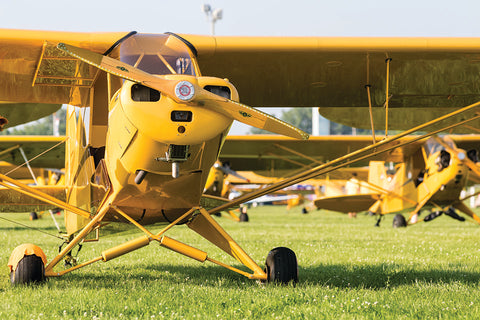The Timeless Charm of the Piper Cub
In the world of aviation, some aircraft stand out not only for their performance but also for their timeless charm and enduring legacy. The Piper J-3 Cub is one such aircraft, a symbol of simplicity, reliability, and the joy of flying. As we delve into the history and features of the Piper Cub, we'll uncover the reasons behind its enduring popularity and its unique place in aviation history.
A Glimpse into History:

The Piper J-3 Cub made its debut in the 1930s, a pivotal era for aviation marked by innovation and exploration. Designed by C.G. Taylor and later refined by Walter Jamouneau, the Piper Cub was initially intended for flight training and leisure flying. Its first flight took place in 1930, and the aircraft quickly captured the hearts of aviators and enthusiasts alike.
The Piper Cub played a crucial role during World War II, serving as a liaison and observation aircraft for the military. Its affordability, simplicity, and remarkable short takeoff and landing (STOL) capabilities made it an ideal choice for various missions. After the war, surplus Piper Cubs flooded the civilian market, contributing to the widespread popularity of this iconic aircraft.
Design and Features:

One of the defining features of the Piper Cub is its unmistakable high-wing design, a characteristic that provides excellent visibility for both pilot and passengers. The fabric-covered wings and fuselage, along with the signature yellow color scheme, give the Piper Cub a distinctive and nostalgic appearance.
Powered by a modest engine, typically the Continental A-65 or A-75, the Piper Cub may not boast the speed of modern aircraft, but its lightweight design and responsive controls offer a delightful flying experience. The simplicity of its design makes maintenance relatively straightforward, contributing to the aircraft's reputation for reliability.
The Piper Cub Experience:

Flying a Piper Cub is not just about getting from point A to point B; it's an immersive experience that harks back to the golden age of aviation. Pilots and passengers alike revel in the wind-in-the-hair sensation, low cruising altitudes, and the freedom to explore the skies in a manner that feels pure and unfiltered.
The aircraft's exceptional STOL capabilities enable it to take off and land in short distances, opening up a world of possibilities for pilots who wish to explore remote airstrips and grass fields. The Piper Cub is not just a means of transportation; it's a ticket to adventure and exploration, echoing the spirit of early aviators who sought to conquer the skies.
Legacy and Enduring Appeal:

Nearly a century after its inception, the Piper Cub continues to captivate aviation enthusiasts and pilots around the world. Vintage aircraft enthusiasts cherish the opportunity to restore and fly these timeless machines, while newer generations of aviators appreciate the Piper Cub's role in shaping aviation history.
In an era dominated by advanced technology and sophisticated aircraft, the Piper Cub stands as a reminder of a simpler, more romantic time in aviation. Its enduring appeal lies not only in its historical significance but also in its ability to evoke a sense of nostalgia and adventure.

The Piper Cub is more than just an aircraft; it's a symbol of the passion for flight that transcends generations. As it gracefully soars through the skies, the Piper Cub carries with it the legacy of a bygone era and an invitation for pilots to experience the pure joy of flying. In a world that constantly evolves, the Piper Cub remains a timeless icon, reminding us of the magic and freedom that come with taking to the skies.

